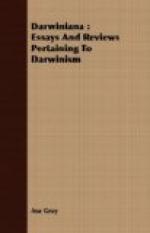The observations which compel such an inference are re-cent, and the substance of them may be briefly stated. The late Rev. Dr. M. A. Curtis (by whose death, two years ago, we lost one of our best botanists, and the master in his especial line, mycology), forty years and more ago resided at Wilmington, North Carolina, in the midst of the only district to which the Dionaea is native; and he published, in 1834, in the first volume of the “Journal of the Boston Society of Natural History,” by far the best account of this singular plant which had then appeared. He remarks that “the little prisoner is not crushed and suddenly destroyed, as is sometimes supposed,” for he had often liberated “captive flies and spiders, which sped away as fast as fear or joy could hasten them.” But he neglected to state, although he must have noticed the fact, that the two sides of the trap, at first concave to the contained insect, at length flatten and close down firmly upon the prey, exerting no inconsiderable pressure, and insuring the death of any soft-bodied insect, if it had not already succumbed to the confinement and salivation. This last Dr. Curtis noticed, and first discerned its import, although he hesitated to pronounce upon its universality. That the captured insects were in some way “made subservient to the nourishment of the plant” had been conjectured from the first. Dr. Curtis “at times (and he might have always at the proper time) found them enveloped in a fluid of mucilaginous consistence, which seems to act as a solvent, the insects being more or less consumed in it.” This was verified and the digestive character of the liquid well-nigh demonstrated six or seven years ago by Mr. Canby, of Wilmington, Delaware, who, upon a visit to the sister-town of North Carolina, and afterward at his home, followed up Dr. Curtis’s suggestions with some capital observations and experiments. These were published at Philadelphia in the tenth volume of Meehan’s Gardeners’ Monthly, August, i868; but they do not appear to have attracted the attention which they merited.




